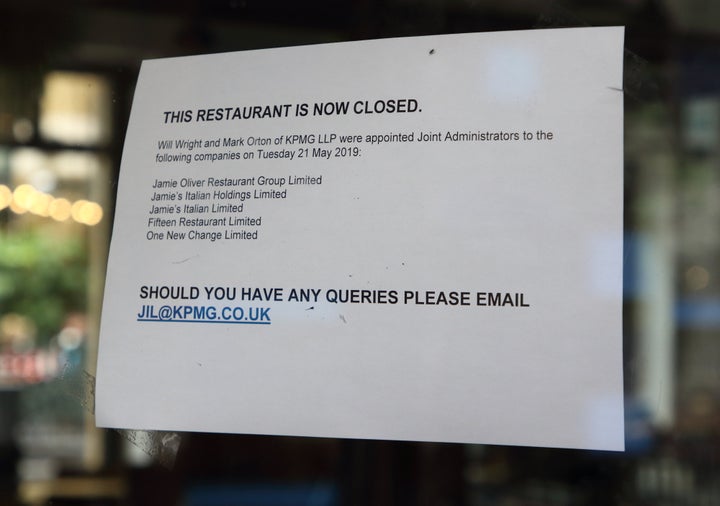When Jamie Oliver announced in 2008 that he was to open up an Italian-style restaurant under his name, there was no shortage of anticipation from fans and critics alike.
Rave reviews piled in from every corner, with high ratings translating to packed tables and queues to get in, beginning with his first restaurant in Oxford.
The TV chef wasn’t new to the trade either. In 2002, he opened Fifteen London, an endeavour captured in five-part Channel 4 series, Jamie’s Kitchen.
The move led to the opening of Fifteen Cornwall, a restaurant and social enterprise which trains up unemployed young people as chefs.
At the height of its success, Oliver’s restaurant empire had swelled to 60 sites worldwide.
But a brand that was once king of the casual dining scene has seen a spectacular fall from grace 11 years later, as Oliver’s restaurant chain on Tuesday announced it was to go into administration, with 1,000 jobs in danger across 25 sites.
A devastated Oliver told his employees: “We launched Jamie’s Italian in 2008 with the intention of positively disrupting mid-market dining in the UK high street, with great value and much higher quality ingredients, best-in-class animal welfare standards and an amazing team who shared my passion for great food and service.
“And we did exactly that.”
Closed restaurants include Jamie’s Italian branches, as well as steakhouse Barbecoa in the City of London, and Fifteen London.
Only three restaurants from Oliver’s group will remain trading in the UK – three at Gatwick Airport and Fifteen Cornwall – while international restaurants trading as Jamie’s Italian, Jamie’s Pizzeria and Jamie’s Deli will not be affected.
So how did the fortunes of a sellout chain turn so dramatically?
High street pressures coupled with Brexit woes
Will Wright, one of the KPMG administrators appointed to the chain on Tuesday, said their efforts came amid a backdrop of “rising costs and brittle consumer confidence”, despite directors working “tirelessly to stabilise the business”.
He described the trading environment across the casual dining sector as “tough as I’ve ever seen”.
New investment into the business, including £13m of Oliver’s own money, had not proved fruitful for the ailing restaurants.
By 2018, Jamie’s Italian was struggling with debts of more than £70m.
“Unfortunately, with insufficient funds available to be able to trade the business in administration, all but the Gatwick airport restaurants have now closed. Our priority in the coming hours and days is to work with those employees who have been made redundant, providing any support and assistance they need,” Wright said in a statement.
Jamie’s Italian is not the only casualty, as a tough trading environment for the sector has manifested in a raft of chain closures and measures to try and mitigate the negative impact.
One year ago, KPMG warned that Britain’s casual dining sector would endure a wave of closures, with a quarter of restaurant groups under severe financial stress in what has been dubbed the “casual dining crunch”.

A number of high street chains – Jamie’s Italian among them – had been earmarked with company voluntary arrangements, which would allow them to pay only a partial amount of their debts. The move allowed them to close loss-making branches.
Byron Burger and Prezzo were also underwent the restructuring plan.
Meanwhile, Pizza Express blamed business rates, rents and rising food prices for a fall in earnings in 2017.
In the same year, Jamie’s Italian lost £20m and six Jamie’s Italian restaurants closed down, after the chain was hit by a combination of rising cost pressures which the chain said was triggered by Brexit.
Tough trading was also cited, with the move impacting 120 staff members – a sign of things to come.
In 2018, 12 of its restaurants were shut, taking the total UK tally to 25.
Rising business rates, the National Living Wage, the Apprenticeship Levy coupled with persistently high inflation and lower footfall made for a dangerous cocktail of pressures.
Staff pressures
Sandra*, a former Jamie’s Italian waitress, told HuffPost UK that her time at the Birmingham branch of the chain was “one of her most treasured” jobs, but that a culture of compensating customers for free after they complained made things difficult.
“Jamie’s Italian had such great management and we were treated as every person wants to be, our team was quite big but we were all friends, there was no competition no hate – it was a family-like feeling.
“The thing I believe has dragged Jamie’s down is, no offence, the culture of ‘I complain and they will give it to me for free’. This system British companies have developed over the years just reinforced the attitude of the customers as they believe everything will come to them for free if they are nasty, rude and arrogant enough.
“Constant giving of free stuff has made our work life and the life of our management hard.”
She had been working to pay for her university tuition, and, although she said things felt normal at the beginning, she soon realised this policy was “not sustainable”.
“Constant giving of free stuff has made our work life and the life of our management hard”
“It was almost impossible when facing this type of customers who just expected it and even complained about insane stuff just to get something for free.
She added: “It is happening rarely in such big corporations that the management would be really nice and genuine.”
“I am sorry for what has happened, the quality of the food was great and staff was amazing, but the system was wrong, she said, adding that cut-price menus for families was going to hit profits.
Another employee at a branch in Glasgow told the BBC that they knew the restaurant wasn’t doing so well, adding that she and her partner had suddenly been made redundant on the spot.
She added that a single staff member could wait up to 11 tables on one night because of reduced staff numbers and restaurants being “far too big”.
The popularity of voucher schemes and offers were also blamed for a failure to retain loyal customers.
Reviews turn sour
“For 37 whole minutes I had stood outside Jamie’s Italian, gurning insanely at diners on the other side of the window in a futile bid to force them out, and the queue had moved all of two inches,” wrote The Guardian’s Matthew Norman in 2008.
The food critic scored the freshly-launched Oxford branch a strong 8.25/10, going on to praise its fair prices and “lavish portions”, adding that it was “worth the wait”.
By 2015, a Soho branch of the restaurant earned anything but praise from The Spectator’s Tanya Gold, who labelled it a “hoax”.
“The pasta course is well-seasoned but overcooked; the Crispy Italian-Spiced Duck Leg has never dreamt of Italy, let alone quacked there; the Italian Steak Frites are French Steak Frites,” she wrote.
“All this is a hoax inflicted on the clients, who have been enticed away from Pizza Express, where they really wanted to eat, by Oliver’s fame.”
Customer reviews followed in a similar vein.
Across TripAdvisor, reviews for the chain across branches seem inconsistent.
From customers complaining of “dire and dirty” settings, to an experience “below expectations” and the brand “trading on its name”, they tell a mixed story.
Others spoke of an “excellent atmosphere” to “amazing food” and “lovely staff”.
Jamie’s Italian isn’t singled out in this. Rather, like other mid-market restaurants chains, his firm is a victim of the casual dining crunch a phenomenon which saw 10,000 restaurant sector jobs lost in 2018.
Rapid growth in the market between 2010 and 2016 slowed dramatically, with a rise in business rates and rents.
Jamie Oliver Group has been approached for comment.
*Some names have been changed.
